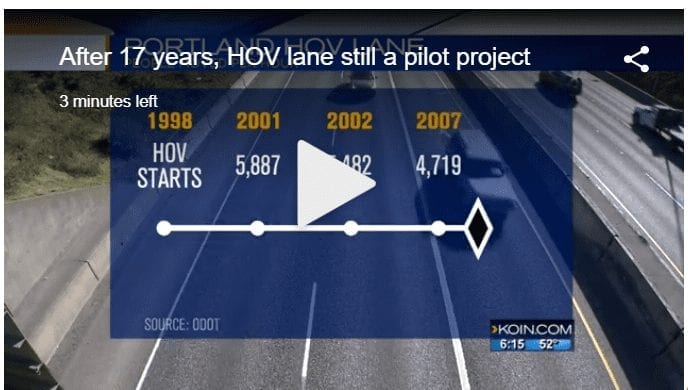John Ley: ‘No private business would pay for an asset that is used at just 1 or 2 percent of its capacity’

C-TRAN says they want a “dedicated lane” for their buses. Vancouver Mayor Anne McEnerny-Ogle has been pushing a new, replacement Interstate 5 bridge, with a dedicated lane for high capacity transit. Both the Southwest Washington Regional Transportation Council (RTC) and Portland Metro’s JPACT have a light rail extension into Vancouver in their future plans. But taking the Vancouver mayor at face value, that she’d be happy with just Bus Rapid Transit, let’s take a closer look at dedicated lanes and the ramifications.
C-TRAN’s Express bus service to Portland carries only 1,499 people on an average day (2016 numbers). Ridership peaked and has been in decline for several years.
The 1,499 people who ride C-TRAN’s Express buses are a rounding error of the 310,000 vehicles that cross the Columbia River on an average day. Increasing mass transit (of any type) will not improve traffic congestion. People don’t want more mass transit.
A recent PEMCO survey indicates 94 percent of people prefer their cars.
The real bottleneck on I-5 is the 2-mile, 2-lane section of I-5 at the Rose Quarter. The Oregon Department of Transportation (ODOT) reports the No. 2 bottleneck in the region is I-5 Southbound beginning at Rosa Parks Way and continuing through the Rose Quarter.
https://www.oregonlive.com/…/portlands_9_worst_highway_bott…
Replacing the existing bridge(s) will not improve traffic congestion. An Oregon Governor’s panel told citizens in 2010 that the Columbia River Crossing (CRC) would improve the morning, southbound commute by one minute. Spending several billion dollars for a one minute improvement is not worth it.
Back to the “dedicated lane.”
The Washington State Department of Transportation (WSDOT) reports that one freeway lane can carry between 1,800 and 2,400 vehicles per hour, depending on vehicle speed. Over 24 hours, that lane could carry between 43,200 and 57,600 vehicles each day.
C-TRAN (and others) are asking for a “dedicated lane.” How many buses would C-TRAN put on that “dedicated lane” each hour? How many buses would C-TRAN put on that dedicate lane each day? Nobody is asking that question.
C-TRAN has 7 Express bus lines into Portland, five of which use the I-5 corridor. (Those 7 lines carry the 1,499 people each day). Most people will want or need to commute from 7-9 a.m., returning home from 4-6 p.m. The rest of the day, there is minimal “demand” for express bus service into downtown Portland.
If the five C-TRAN Express bus lines run every 10 minutes from 7-9 a.m., how many people will the buses carry, and more importantly, how many vehicles will be driving in the dedicated lane?
If the Express buses run every 10 minutes, that’s six buses each hour. (Present service is five per hour maximum.) There are five separate Express lines using I-5, meaning 30 Express buses would use a “dedicated lane” each hour. But only during the hours people are commuting to and from work. Most likely 2-3 hours in the morning and 2-3 hours in the evening.
Ignored in the discussion is the question — how many vehicles are not able to use the new lane?
If 30 C-TRAN buses use a new “dedicated lane” each hour, that means 1,770 to 2,370 vehicles are stuck in the other congested lanes. Creating a “dedicated lane” hurts 1,700 to 2,300 cars and trucks each hour. That’s 20,400 to 27,600 vehicles over a 12-hour period — 6 a.m. to 6 p.m. when people are most likely to use the road. It doesn’t make sense to harm 20,000 vehicles, simply to benefit 30 C-TRAN buses each hour, or 360 (mostly empty) C-TRAN buses over the same 12-hour period. It’s not efficient use of a new freeway lane.
We see what happens with a “dedicated lane” in Portland on the only HOV lane in the state. In the evening, just before 3 p.m., traffic gets jammed up on I-5 north as vehicles are forced to merge into the two general purpose lanes. Vehicle speeds slow to just 13-15 mph. That is half the average speed of the morning southbound commute which doesn’t have an HOV lane.

Furthermore, Oregon’s HOV lane began in 1998. Data from 2001 shows the HOV lane plus the other two lanes moved 5,887 people per hour. But over the years, the number of people getting through northbound I-5 has plummeted. In 2002, it moved 5,482 people; 2007 it dropped to 4,719. In 2013, data shows 4,527 people got through per hour, a drop of 24 percent.

No private business would pay for an asset that is used at just 1 or 2 percent of its capacity. The taxpayers are not well served by spending hundreds of millions of dollars on a new freeway lane, only to have it rarely used, and only used by buses that carry so few (1,499) people on an average day.
John Ley
Camas




